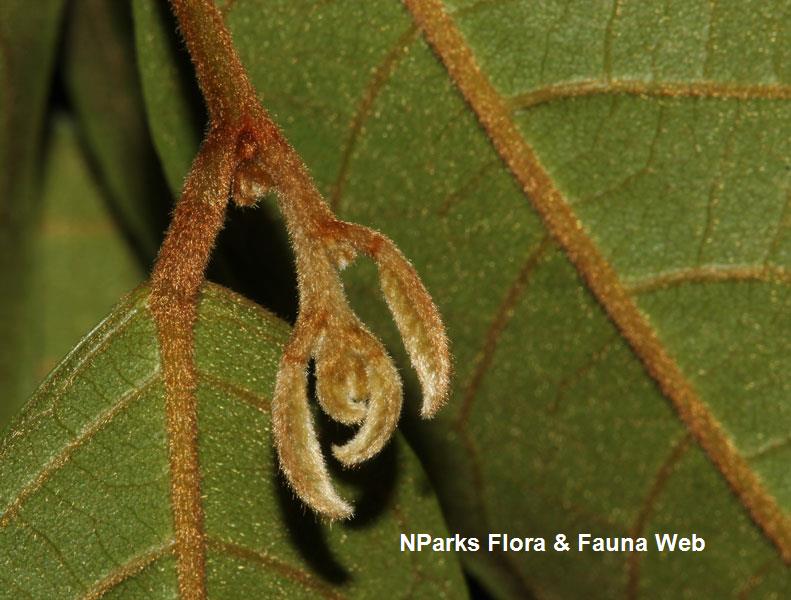
Back
Ellipanthus tomentosus Kurz
| Family Name: | Connaraceae |
| Common Name: | Kerantai Merah |
Ellipanthus tomentosus or Kerantai Merah is a tree native to Singapore. Growing between 25 - 30 m tall, it has papery to leathery, elliptic to lanceolate leaves, hairs found on both sides of the midrib. Flowers are fragrant and said to have a strong sweet scent like Coffee and Ylang ylang, greenish to cream white, petals are ovate to linear, hairy on both sides held on an inflorescence found along the axils or branches. The fruit is bent, oval, blunt or shortly beaked, densely hairy, yellowish or brownish. Upon maturity, it spilt lengthwise by a slit to reveal a single, elliptic, shiny seed with a yellowish to orange seed covering.
Name
Classifications and Characteristics
| Plant Division | Angiosperms (Flowering Seed Plants) (Dicotyledon) |
|---|---|
| Plant Growth Form | Tree (Big (>30m), Medium (16m-30m)) |
| Maximum Height | 30 m |
Biogeography
| Native Distribution | Mynamar, Vietnam, Cambodia, Laos, Sumatra (including Simalur), Malay Peninsula, Singapore |
|---|---|
| Native Habitat | Terrestrial (Primary Rainforest, Secondary Rainforest) |
| Preferred Climate Zone | Tropical |
| Local Conservation Status | Native to Singapore (Critically Endangered (CR)) |
Description and Ethnobotany
| Growth Form | It is a medium to large sized tree that can grow from 25 - 30 m tall. |
|---|---|
| Foliage | Leaves are papery to leathery, elliptic to lance-shaped, sometimes spoon-shaped, measuring 7 - 33 cm long by 3 - 9 cm wide. Hairs found along the midrib on the top surface, less hairy to smooth on the underside. |
| Flowers | Flowers are held on an inflorescence found along the axils or branches (ramiflorous). The inflorescence is 2 cm long, many to few-flowered, covered in dense hairs. Flowers are fragrant, greenish to cream white, petals are egg-shaped to linear, blunt, hairy on both sides measuring 2 - 4.5 mm long by 1.25 - 2.5 mm wide. The fragrance is said to be strong, sweet like Coffee or Ylang ylang. |
| Fruit | The fruit is bent, oval, blunt or shortly beaked, measuring 2 - 4 cm long by 0.75 - 1.25 cm wide, densely hairy, yellowish to brownish. Upon maturity, it splits by lengthwise by a slit revealing a single, elliptic, shiny, black seed. The seed is 12 - 20 mm long by 6 - 10 mm wide, often flattened, blunt on both ends with a deeply lobed, yellowish to orange seed covering (arilloid) enclosed 2/3 of the seed. |
| Habitat | Occurs in rainforests, deciduous jungle up to 700 m altitude. <1> |
| Cultivation | It can be propagated by seed. |
Plant Care and Propagation
| Light Preference | Full Sun |
|---|---|
| Water Preference | Moderate Water |
| Plant Growth Rate | Moderate |
| Rootzone Tolerance | Fertile Loamy Soils, Well-Drained Soils |
| Propagation Method | Seed |
Foliar
| Foliage Retention | Evergreen |
|---|---|
| Foliar Type | Simple / Unifoliate |
| Foliar Arrangement Along Stem | Spiral |
| Foliar Attachment to Stem | Petiolate |
| Foliar Shape(s) | Non-Palm Foliage (Elliptical, Lanceolate, Obovate) |
| Foliar Venation | Pinnate / Net |
| Foliar Margin | Entire |
| Foliar Apex - Tip | Acuminate, Acute |
| Foliar Base | Acute, Rounded / Obtuse, Cordate |
Non - Foliar and Storage
| Stem Type & Modification | Woody |
|---|
Floral (Angiosperm)
| Flower & Plant Sexuality | Bisexual Flowers , Bisexual Flowers |
| Flower Colour(s) | Cream / Off-White, White, Green |
|---|
| Flower Grouping | Cluster / Inflorescence |
| Flower Location | Axillary, Cauliflorous |
| Flowering Habit | Polycarpic |
Fruit, Seed and Spore
| Mature Fruit Colour(s) | Yellow / Golden, Brown |
|---|---|
| Fruit Classification | Simple Fruit |
| Fruit Type | Dehiscent Dry Fruit , Capsule |
| Mature Seed Colour(s) | Black |
| Mature Seed Texture(s) | Glossy / Shiny |
References
| References | <1> Leenhouts, P.W. (1958). Connaraceae. In: Van Steenis, C.G.G.J. (ed.) Flora Malesiana, ser. 1, Seed Plants, vol. 5, pp. 521-523. Jakarta: Noordhoff-Kolff N.V. |
|---|
Image Repository
Others
| Master ID | 34444 |
|---|---|
| Species ID | 8857 |
| Flora Disclaimer | The information in this website has been compiled from reliable sources, such as reference works on medicinal plants. It is not a substitute for medical advice or treatment and NParks does not purport to provide any medical advice. Readers should always consult his/her physician before using or consuming a plant for medicinal purposes. |


